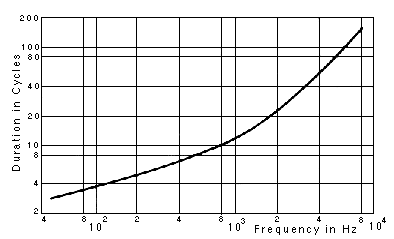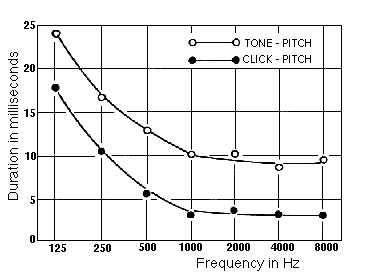|
|
When the duration of a sound is less than the time threshold required for PITCH recognition, the sound is heard as a click, rather than a TONE. The sound itself is usually called a click.
Compare: GRAIN, IMPACT SOUND, PULSE.
The time or duration threshold depends on the number of CYCLEs or PERIODs present in the sound and therefore is FREQUENCY dependent, as can be seen from the graph. At 1000 Hz, for instance, the duration of a pure tone must be about 12 ms for the pitch to be recognized. With instrumental sounds, the threshold depends on the kind of ATTACK or onset of the sound, being less for soft onsets.
A general principle, as stated in the LAW OF UNCERTAINTY, is that frequency cannot be determined more precisely than the inverse of the total duration of the sound. For 12 cycles of a 1 kHz tone, then, the uncertainty in the frequency would still be about 80 Hz. After about 40 ms, a steady pitch can be ascribed.
The apparent LOUDNESS of a click will fall off below about a half second, as can be heard in the accompanying sound example.
When a sound has a sharp attack, the onset TRANSIENTs are heard as a click. Similarly, any sudden transient in a sound will be heard as a click (see ENVELOPE). Sounds similar to clicks are used to test BINAURAL HEARING and to determine REVERBERATION time.
When a tape SPLICE is incorrectly made, as in a TAPE LOOP, a click or 'bump' may result.

The duration of a tone in cycles required to ascribe a definite pitch (from Olson, Music, Physics and Engineering, Dover, 1967, p. 250, after Burck, Kotowski, and Lichte; von Békésy and Turnbull, used by permission).
![]() Sound
Example: 1 kHz sine tone with duration
of 40 ms being shortened to a 2 ms broad-band click.
Sound
Example: 1 kHz sine tone with duration
of 40 ms being shortened to a 2 ms broad-band click.
home
